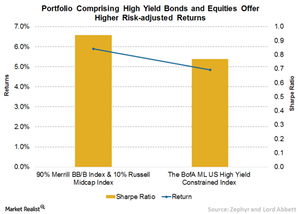How Portfolio Rebalancing Boosts Overall Returns
AB Rebalancing in the Tails Because stocks have been so much more volatile than high yield, periodic portfolio rebalancing tends to occur during performance extremes—the “tails” in return distributions—when the gap between high-yield and equity returns is wide. This magnifies the “buy-low, sell-high” effect that rebalancing contributes to a portfolio’s performance. Of course, the gaps […]
April 10 2017, Updated 4:05 p.m. ET

AB
Rebalancing in the Tails
Because stocks have been so much more volatile than high yield, periodic portfolio rebalancing tends to occur during performance extremes—the “tails” in return distributions—when the gap between high-yield and equity returns is wide. This magnifies the “buy-low, sell-high” effect that rebalancing contributes to a portfolio’s performance. Of course, the gaps between returns on stocks and investment-grade bonds would also be sizable if those two classes were paired in a portfolio, but investment-grade bonds wouldn’t contribute as much performance potential as high yield.
Over the same time period referred to in the earlier example, investors could have split their portfolio 50/50 between stocks and high yield. This would have slashed volatility from 15.2% to 10.7%—while allowing investors to still nearly match the 10.9% annualized hypothetical equity return.
Market Realist
An ideal way to enhance returns
Portfolio rebalancing instills a greater degree of discipline while investing in stocks and bonds. It helps book profits when stocks generate positive returns while reinvesting the proceeds in asset classes that are expected to generate higher returns in the future. To lessen the impact of higher volatility in equities, you can reallocate assets to investment-grade bonds. However, this approach lowers a portfolio’s return potential. A portfolio comprising stocks and high yield bonds (HYG) (HYS) is an ideal way to enhance returns while lowering overall volatility. However, it is critical for investors to choose their stock and high yield bonds (BKLN) very carefully.
Enhanced portfolio returns
A study by Zephyr and Lord Abbett revealed that a portfolio with a 90% exposure to the BofA Merrill Lynch Single B US High Yield Index and the BofA Merrill Lynch BB US High Yield Index (JNK) (SJNK) and a 10% exposure to the Russell Midcap Index has slightly more defensive characteristics than investments in the high yield index. The portfolio was also found to have a lower beta, better risk-adjusted returns, and a lower downside risk. Over the five-year period ended 2015, the aforementioned portfolio generated an attractive return of 5.9%, compared with 4.8% by the BofA ML US High Yield Constrained Index. Also, the portfolio had a higher Sharpe ratio of 0.94, compared with the index’s 0.77.
